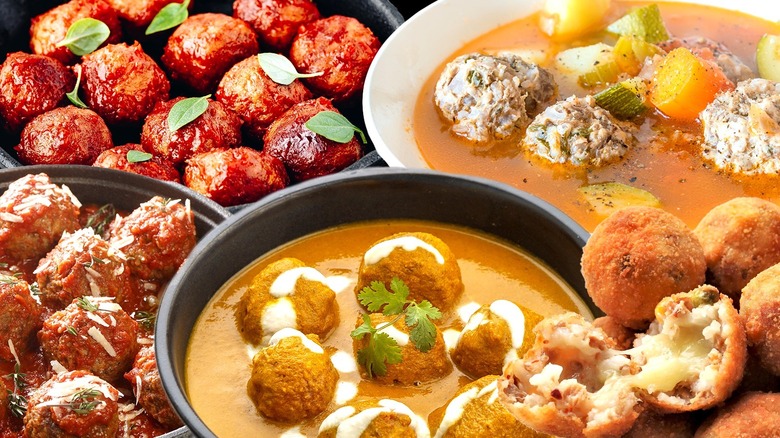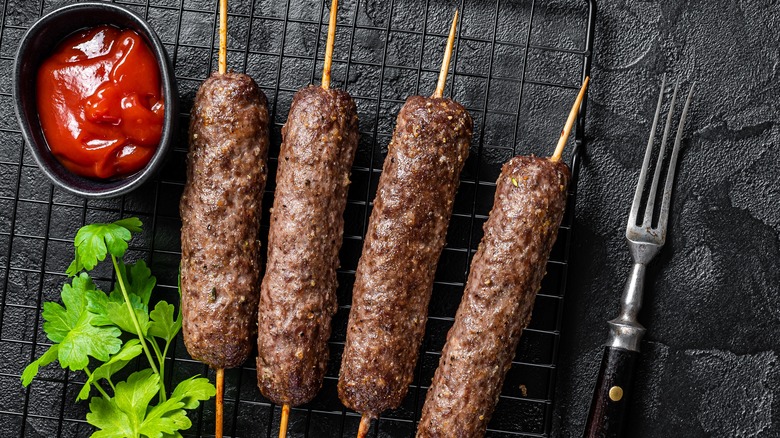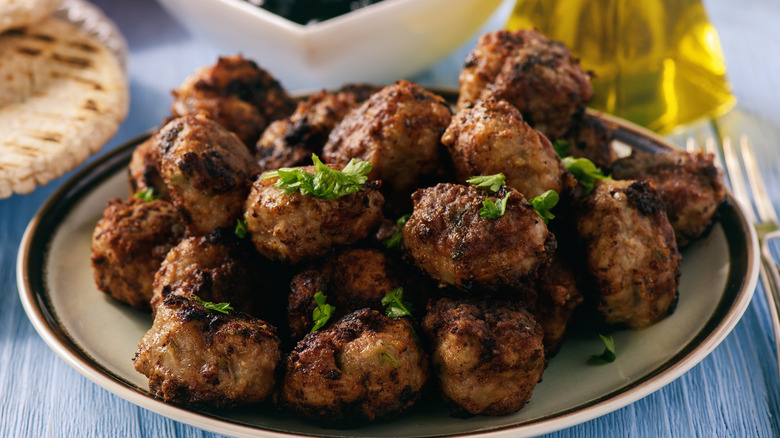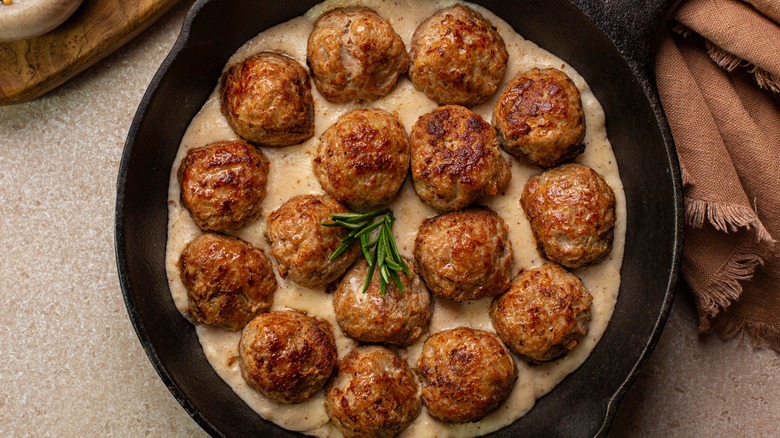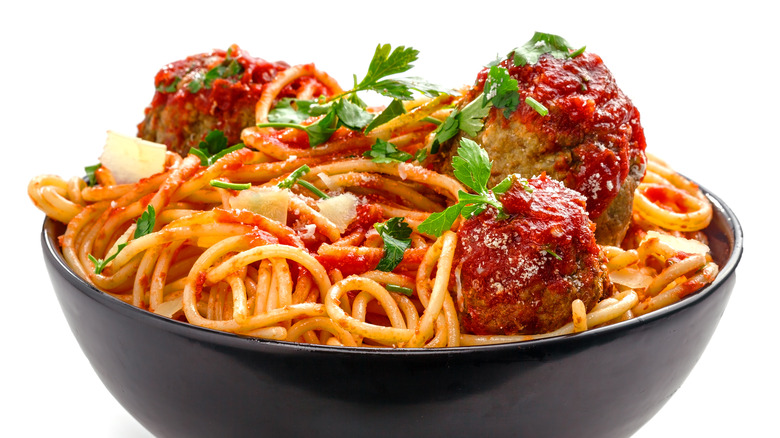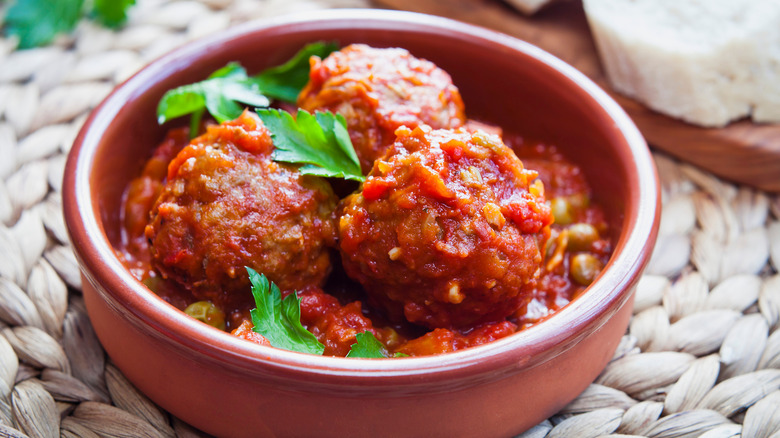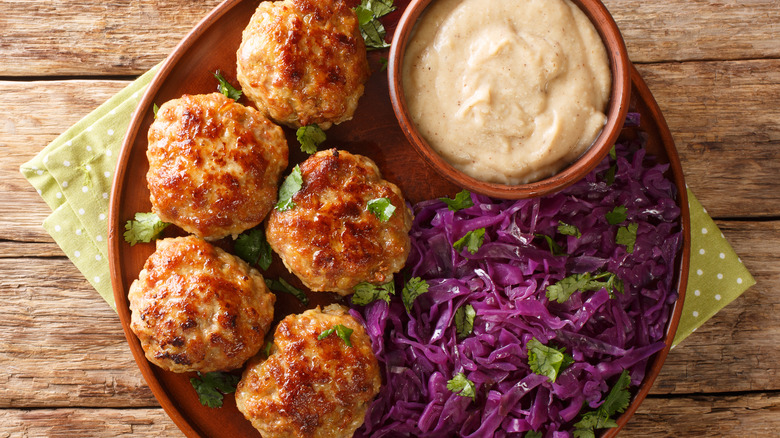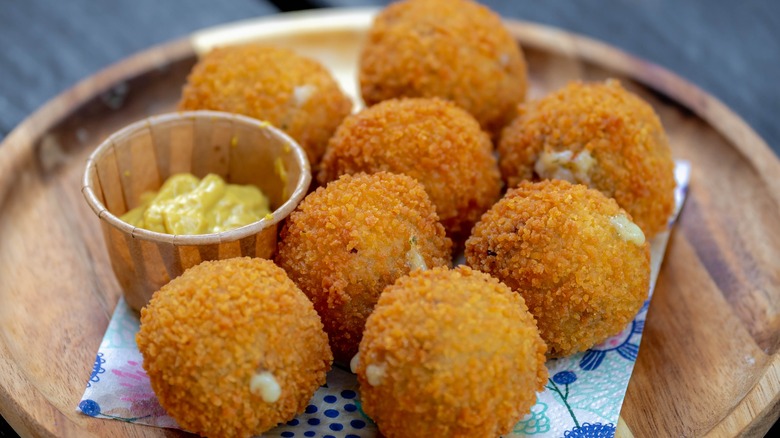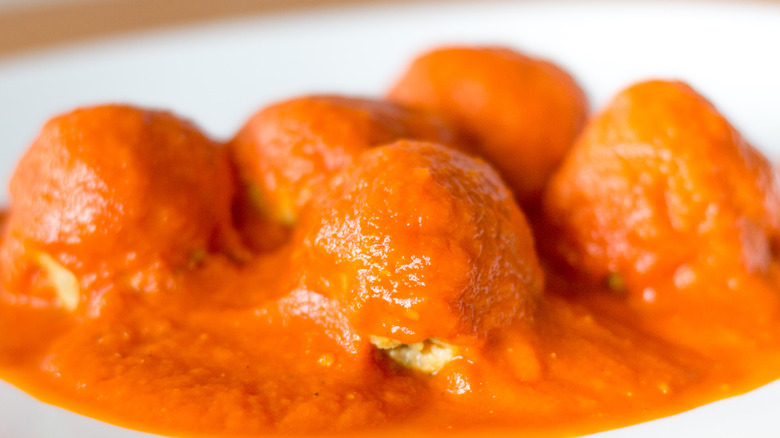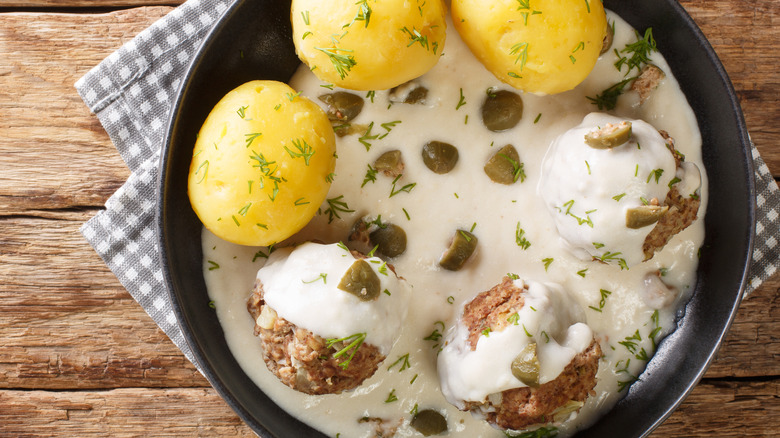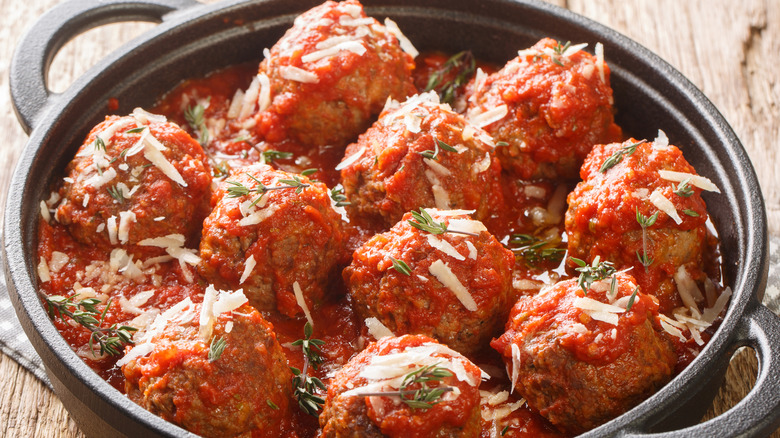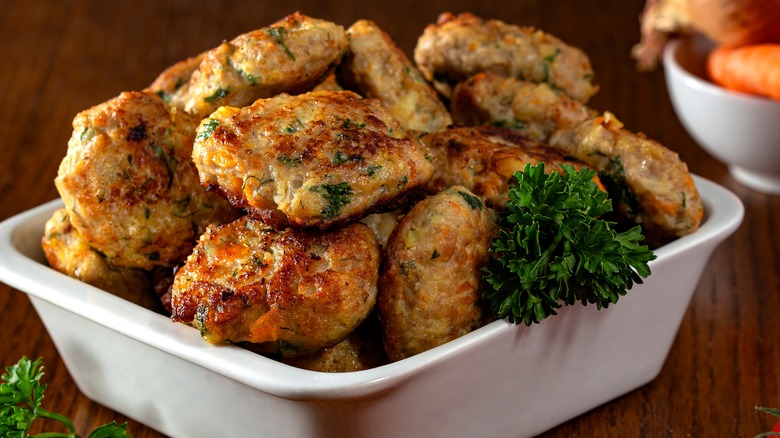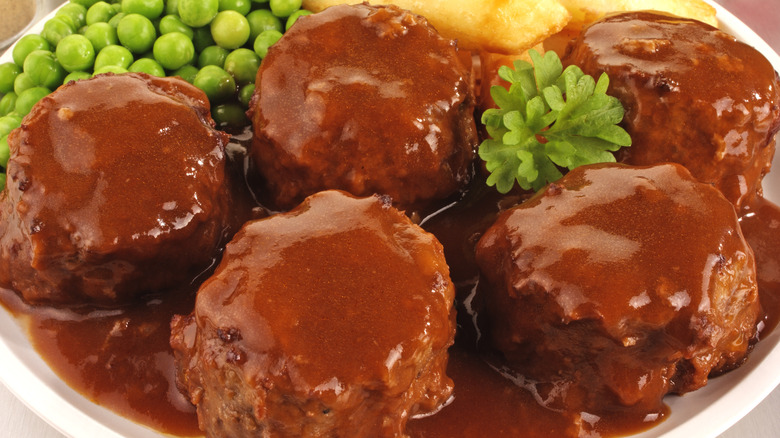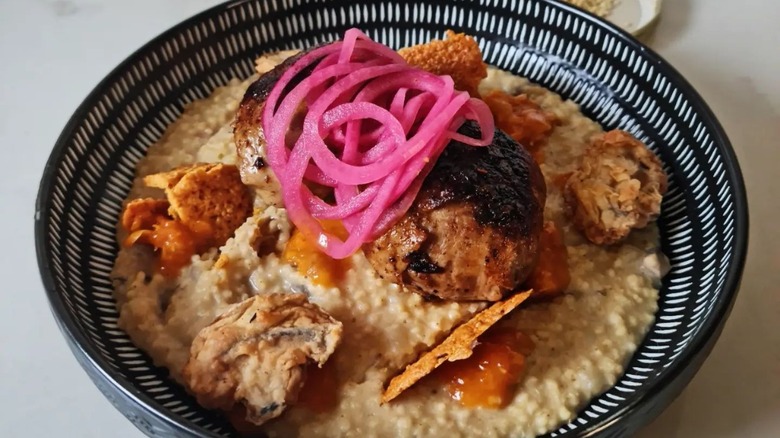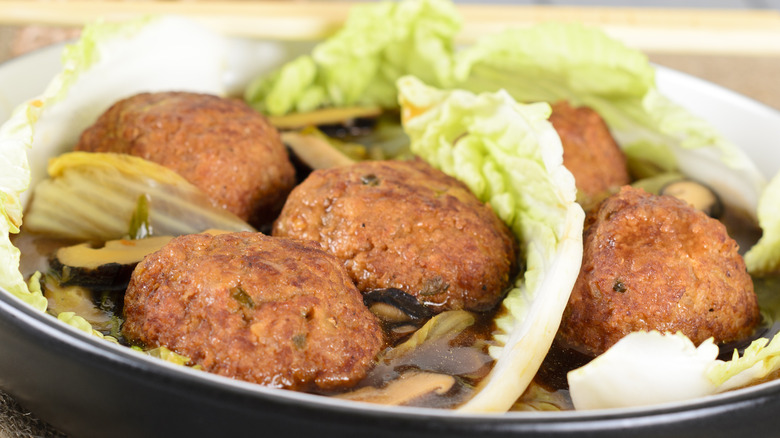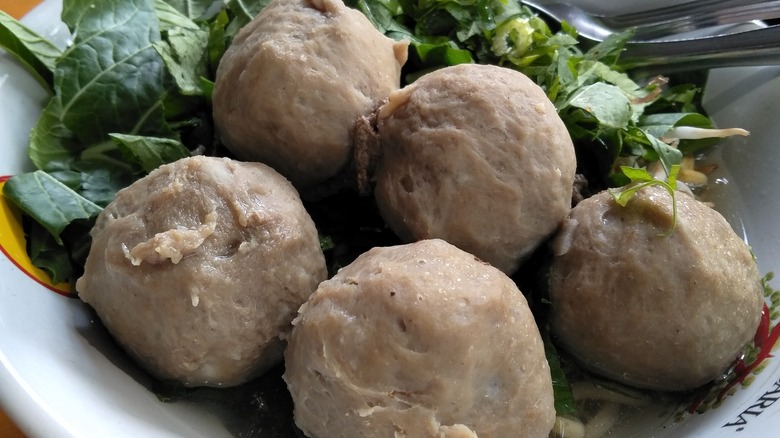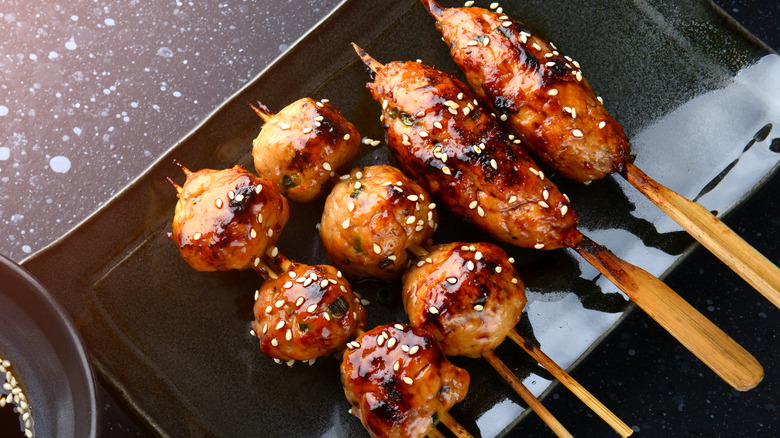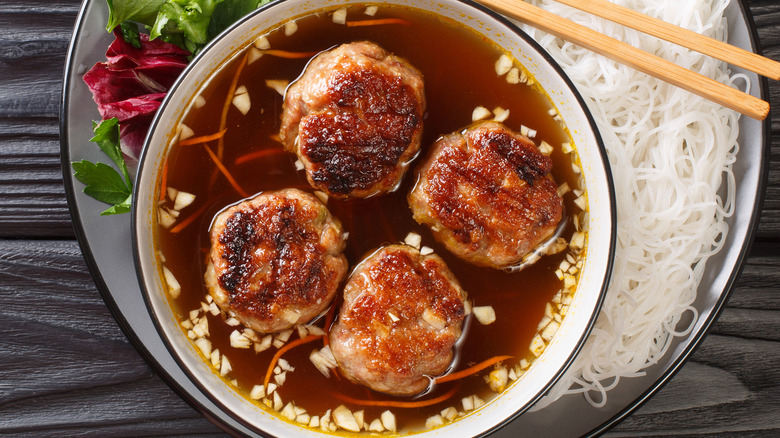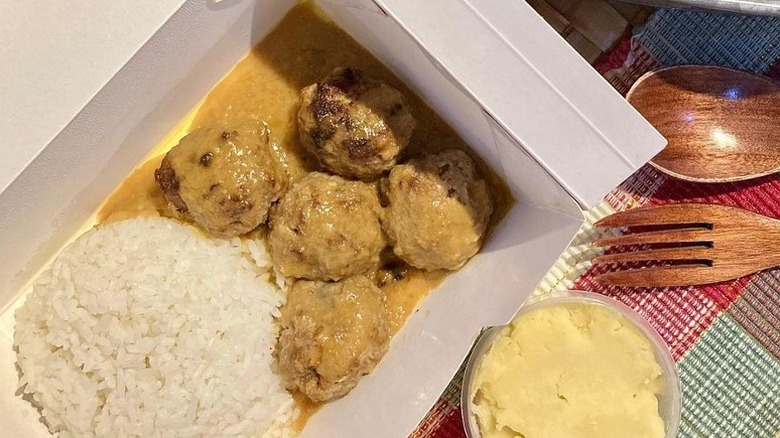18 Types Of Meatballs From Around The World
A lot of the time we pretend that food is different in other parts of the world. Sure, the level of spice might go up or down and the sauces might be another color, but if you think about it, many of our most beloved dishes resemble each other. Take meatballs, for example. Some are served au natural while others are covered in sauce. Certain meatballs are made out of pork, while others have a chicken base.
But, despite these differences, you know a meatball when you see one. And no matter where you are, these round, appetizing morsels are the star of whichever dish they're a part of. In honor of these dependable culinary bites, we've compiled a list of 18 types of meatballs from around the world. From the original meatballs of the Middle East to the New World version served atop a pile of spaghetti, you'll discover everything there is to know about this unifying dish.
Kofta
Originally from Persia, kofta is widely considered to be the OG of meatballs. As proof, the word kofta comes from the Persian word kūfta meaning to beat or grind. Most often, they're made with red meat, such as beef or lamb, but fish and vegetable kofta are also popular. Because they're a mainstay in Muslim countries, pork is the only meat that's off-limits when preparing kofta.
From the Balkans to North Africa, kofta are found all over the world. That said, they're most popular in Middle Eastern and South Asian cuisines. Owing to their worldwide spread, kofta comes in all kinds of variations. For example, Middle Eastern koftas are made with ingredients such as onions, mint, cumin, coriander, and rice. They're typically grilled or roasted and served kabab style. In contrast, Indian kofta (such as malai kofta) is made out of potatoes and served in a creamy, curry-based gravy.
Keftedes
One of the direct descendants of Persian kofta, keftedes (also written as keftethes) are pan-fried lamb or beef meatballs from Greece. Pan-frying creates a satisfyingly crispy exterior while leaving the inside nice and juicy. In addition to meat, keftedes contain typical meatball ingredients like garlic, red onion, red wine vinegar, and breadcrumbs. They also feature traditional Mediterranean flavors like fresh parsley, oregano, and spearmint.
Keftedes are usually served as an appetizer or as part of a mezze platter accompanied by tzatziki sauce, olives, and pita bread. However, it's not uncommon to see them alongside a hearty slice of moussaka or a fresh Greek salad. Alternatively, they can be combined with orzo and tomato sauce to create a complete dish called keftedes giouvetsi. But perhaps the easiest (and most delicious) way to serve keftedes is by stuffing a few into a warm slice of pita bread with some veggies and hummus.
Köttbullar
Köttbullar, better known as Swedish meatballs, are pan-fried meatballs made from a combination of beef and pork. The base is fairly easy to whip up. Simply combine the minced meat with chopped onion, garlic, breadcrumbs, and egg. Finish with a touch of salt and pepper before frying. Some recipes also call for allspice and nutmeg but these ingredients are optional.
Based on the meat alone, köttbullar doesn't exactly stand out. But, it's not so much the meat that makes them so delicious, it's the savory sauce they're covered in. This delectable sauce is made from a combination of butter, flour, broth (chicken and beef), heavy cream, soy or Worcestershire sauce, and Dijon mustard. The resulting roux is tangy, creamy, and all kinds of delicious.
Finish with some lingonberry jam and serve them alongside fluffy mashed potatoes. Now that you know the secrets of Swedish meatballs, you can stop pretending to go shopping at Ikea just to buy them.
Italian meatballs
No list of meatballs from around the world would be complete without mentioning the Italian meatball recipe. Although, based on their history, it's much more accurate to call them Italian-American meatballs. The version we all know and love was invented by Italian immigrants in New York City sometime around the turn of the 20th century. Although they were familiar with meatballs (albeit smaller and less saucy ones), this dish was much less common in Italy due to the price of meat.
Discovering that the cost of ground beef was fairly inexpensive in the New World, Italian Americans created ever-larger meatballs. They paired these meaty delights with other inexpensive, easy-to-use ingredients like canned tomatoes and pre-made pasta to create the iconic spaghetti and meatballs famous in the United States. While ordering this simple dish is a no-brainer in the states, it's best to avoid it if you ever see it on a menu in Italy.
Albondigas
Along with patatas bravas and ham croquettes, albondigas are a standby on just about every tapas restaurant in Spain. They're made from a combination of meats, usually veal, pork, or lamb. Unlike some meatball recipes that call for a lot of herbs and aromatics, albondigas have a simple base of onion, garlic, parsley, salt, and pepper. In addition, some recipes call for soaked bread while others use rice.
In Spain, you'll most likely find these bite-sized delights simmered in a tomato sauce seasoned with paprika, cumin, and cilantro alongside a healthy portion of bread. However, there are all kinds of albondigas variations throughout the Spanish-speaking world. In Mexico, they're often served in a soup made with chicken broth, green beans, onions, and carrots. Meanwhile, in the Philippines, almondigas (as they're called there) are served in a hearty misua (noodles) or rice soup. Additional ingredients include chicken broth, fish sauce, and egg.
Frikadeller
Although less famous than their Swedish counterparts, Denmark's pan-fried, pork-based meatballs are just as comforting and crave-worthy. Unlike most meatballs that have a round shape, frikadeller are small and slightly flattened on the bottom. This prevents them from rolling around in the pan and makes cooking them evenly a lot simpler.
Making frikadeller is pretty easy. The main ingredients (eggs, flour, breadcrumbs, and garlic) are pretty standard meatball fixings. What sets them apart from other meatballs is the addition of nutmeg and sage. The typical frikadeller gravy is also a killer. It combines frikadeller droppings, flour, cream, and beef stock to create a ridiculously creamy base for these tasty morsels. As a main dish, they're paired with boiled red potatoes, sweet and sour cabbage, and other vegetables. If you want to go full Danish, serve them in an open-faced rye bread sandwich topped with mayo and a side of pickles.
Bitterballen
Taking their name from bitters like jenever, a gin-like Dutch liquor, bitterballen are bite-sized beef meatballs that are breaded and deep-fried before serving. While they were originally served with harder beverages, today you'll most often find them alongside a crisp lager in snack bars throughout the Netherlands.
To make them, start with a butter and flour roux. Once that's set, add beef broth, meat, onion, and spices (parsley, salt, pepper, and nutmeg). As strange as it sounds, if you end up with gooey dough, you're on the right track. That's why the next step, refrigerating the dough for a few hours, is so crucial. Once you've formed the bitterballen, dredge the balls in flour, eggs, and then breadcrumbs. Fry them in vegetable oil for 4 to 5 minutes before serving.
What you'll get are meatballs with a satisfyingly crispy exterior and a melt-in-your-mouth interior. For the full Dutch experience, pair them with spicy mustard and cubes of Gouda.
Klopsiki
From pulpety to pulpeciki and finishing with klopsiki, there's no shortage of meatballs in Polish cuisine. That makes choosing just one a tough undertaking. However, klopsiki don't get nearly enough attention for how good they are, so they're our focus. Klopsiki are most often made from ground pork or beef, although poultry versions are also possible. As with most meatballs, they contain simple ingredients like breadcrumbs, eggs, and spices like cloves and marjoram. Alternatively, some versions are stuffed with cheese or mushrooms.
Although they take their name from the Polish word kłopot, meaning trouble, don't get overwhelmed by this sometimes complicated dish. Essentially all you need to do is combine all of the ingredients, form balls, and simmer them in a tomato-based sauce. Once your masterpiece is complete, serve this comfort food with boiled potatoes for a complete meal. As an alternative, pair them with sour cream as a side dish to a green salad.
Königsberger klopse
Taking their name from the Prussian city of Königsberg, these traditional German meatballs were renamed Kochklopse (boiled meatballs) after World War II. Owing to the fact that they're served with gravy, these meaty morsels are also referred to as soßklopse (sauced meatballs). Whatever you decide to call them, these pork and beef meatballs are the true definition of comfort food.
While the basic ingredients (eggs, beef broth, breadcrumbs, and allspice) probably won't surprise you, the addition of anchovy paste and capers just might. Both of these ingredients are scarce in German cuisine, so it's only natural to wonder how they became essential elements of königsberger klopse. It's because their home city, Königsberg (modern-day Kaliningrad, Russia) was a port city, something that provided access to such exotic ingredients. Königsberger klopse are served in a savory sauce made from butter, flour, lemon juice, and whipping cream. Serve them with a side of boiled potatoes and you've got one of Germany's most beloved dishes.
Polpette
Traditional Italian meatballs, called polpette, have very little in common with their American counterparts. For one thing, they're quite a bit smaller than the meatballs most Americans grew up eating. Compared to the tennis ball-sized rounds served in America, polpette are about the size of a walnut shell. What's more, they usually include a combination of ground beef and veal, but it's also possible to make them with poultry, fish, or ricotta cheese. Beyond that, the methods of cooking polpette are much more varied. Indeed, they can be baked, fried, or simmered in tomato sauce.
Perhaps the most noticeable difference is that polpette aren't served with pasta. Rather, Italians serve a pasta dish first, then follow it up with the meat course (secundo). Still, despite the differences, the way polpette are served (covered with tomato sauce, freshly grated Parmesan cheese, and chopped parsley) won't look entirely foreign to American foodies.
Chiftele
Made from a combination of ground pork and shredded potatoes, deep-fried chiftele are a staple of Romanian cuisine. Way back when Romanians added potatoes and other vegetables (mainly zucchini and carrots) to compensate for the lack of meat. Nowadays, adding potatoes lends tons of moisture to the meat. The result is juicy meatballs that have less of a bready flavor than their counterparts from elsewhere around the world. What's more, since the potatoes are already baked in, there's no reason to prepare a separate potato side dish.
Besides the two main ingredients, chiftele contain eggs, breadcrumbs, onion, and garlic. Fresh herbs like parsley and dill are also essential for creating a distinctly Romanian flavor profile. Another interesting feature of these meatballs is their shape. Traditional round balls are more common, but plenty of locals also flatten them to form a more patty-like shape. Once they're done cooking, serve chiftele with sour cream or mustard
Ffagadau
We're not even going to try pronouncing the name of these traditional Welsh meatballs. But, just because their name is a mouthful, doesn't mean you should ignore them. On the contrary, these roasted pork, liver, and heart meatballs are well worth sampling. Besides the organs, ffagadau contain pretty typical meatball ingredients like breadcrumbs, onions, and herbs (sage, allspice, and thyme). Where things get really interesting is in the addition of caul fat and sherry. The 3-inch meatballs are wrapped in fat before baking in the oven for 10 to 15 minutes. To keep them moist, baste them with the meat juice and a bit of sherry. It may sound funky, but the resulting dish is like no meatball you've ever tried before.
Once they come out of the oven, ffagadau are served in a delectable brown gravy made from butter, yellow onion, flour, beef stock, sherry, and heavy cream. Typically, they come with a side of mashed potatoes and buttered peas.
Skilpadjies
Also called muise and vlermuise, skilpadjies (or little turtles in Afrikaans) are one of the only meatballs to come out of Africa. This South African version is made out of minced lamb livers and wrapped in fatty kidney membranes to hold it all together.
Never one to waste anything, the South Africans who made the original skilpadjies used pretty much every part of the lamb, including the rump, liver, and breast. The lamb meat is combined with scallions, onion, and coriander before being wrapped in a layer of caul fat. Not only does the fat add an additional level of flavor, but it also provides a gluten-free method for binding the meatballs together. Once secured, the balls are slow-cooked over a charcoal grill, called braai in Afrikaans) until the fat is nice and crisp. To cut down the savoriness, skilpadjies are usually served with toasted bread or mealie pap, a white maize porridge.
Lion's Head
As their name implies, Lion's Head meatballs are large pork meatballs. They're a staple in Jianghuai or Huaiyang regional cooking, a style originating in Eastern China, and became popular in Shanghainese cuisine. Like a lot of dishes to come out of this region, Lion's Head meatballs are slightly sweet and low on spiciness. Although simple, they're often part of fancy, banquet-style meals.
Something amazing about Lion's Head is that they can be prepared in two different ways: The so-called plain version involves steaming the meatballs in broth and then serving them with a side of napa cabbage. This cruciferous vegetable is meant to represent the lion's mane. On the other hand, the red version is braised in soy sauce. Regardless of the presentation, Lion's Head must contain Shaoxing rice wine, sesame oil, and water chestnut. For the full festival-meal experience, pair Lion's Head with traditional dishes such as rice, steamed fish, black pepper chicken, marinated beef, stir-fry, and cucumber salad.
Bakso
Coming from Indonesia, bakso (or baso) are a popular food in the island nation. So popular, in fact, that you're just as likely to see them at a street food cart as you are in a fancy restaurant. Despite their popularity, their origin story is a bit hazy. Some claim that they were brought to Indonesia by Chinese immigrants, while others believe they were inspired by the meatballs brought to the country by Dutch colonialists. The one thing no one is debating is how delicious bakso are.
The word bakso refers to plain meatballs, while mee bakso is the complete meatball soup. In either case, they're made out of beef (bakso sapi), chicken (bakso ayam), or pork (bakso babi). When served alone, they're often paired with spicy, chili-based condiments like sambal igo and red sambal. However, basic soy sauce is also a popular option. In their soup form, mee bakso can be paired with a combination of egg noodles, rice vermicelli, wontons, and tofu.
Tsukune
Unlike a lot of Asian meatballs that are boiled or served with soup, Japan's answer to these culinary hard hitters is grilled yakitori style. Another notable break from other styles is that tsukune meatballs are made out of chicken, rather than beef or pork. It's probably also worth mentioning that tsukune are more log-shaped than round. But, all of that aside, tsukune are just straight-up delicious.
While you can't go wrong with grilled meat, it's really the tare, a sweet soy sauce-based glaze that makes tsukune shine. To make the perfect Japanese tare sauce recipe, combine mirin, soy sauce, sake, dark brown sugar, and sherry vinegar. Additional ingredients include garlic, scallions, ginger, and peppercorns. Cook the meatballs on two sides before applying a thin layer of tare. This seals in the flavor and creates an eye-catching glaze. Serve them as an appetizer with other Japanese munchies like edamame or gyoza or with steamed rice and pickles for a complete meal.
Bún chả
After pho, bún chả is probably one of the most famous foods to come out of Vietnam. Heck, even Anthony Bourdain and Barack Obama chose this humble dish while shooting in Vietnam. Believed to be originally from Hanoi, these tasty bites are now a lunchtime staple all over the country. Bún chả are slightly flattened pork meatballs served nestled on top of cold vermicelli noodles with a side of fresh veggies like beansprouts, lettuce, carrot, and daikon. They're finished with a drizzle of traditional Vietnamese fish sauce called nuoc cham and paired with herbs like cilantro and mint.
To make the perfect bún chả, combine minced pork with fish sauce, white sugar, scallions, garlic, and lemongrass. Pan-fry them in vegetable oil for 4 minutes total (2 minutes on each side). Let them cool a bit before assembling your bowl. While this dish feels rich, don't feel guilty about having seconds — bún chả is surprisingly light.
Bola-bola
Coming from the Tagalog term for meatball, bola-bola are made from a combination of ground beef or pork, grated onion, chopped carrots, soy sauce, and oyster sauce. For those familiar with Filipino cuisine, bola-bola are kind of like lumpia, minus the spring roll wrapper.
Once all the ingredients are combined, mix in a bit of flour to hold the balls together. Next, deep fry them in vegetable oil for about 5 minutes or until crispy. When it comes to serving bola-bola, there's no right or wrong way. For instance, you can serve them alone with your favorite dipping sauce as an appetizer, or you can drop a few into a bowl of almondigas, a noodle soup perfect for cooler days. But that's not all: Serve them with pasta to create the perfect Filipino-style spaghetti or use them as a filling for siopao steamed buns. Or, pair bola-bola with white rice for a simple weeknight dinner.
